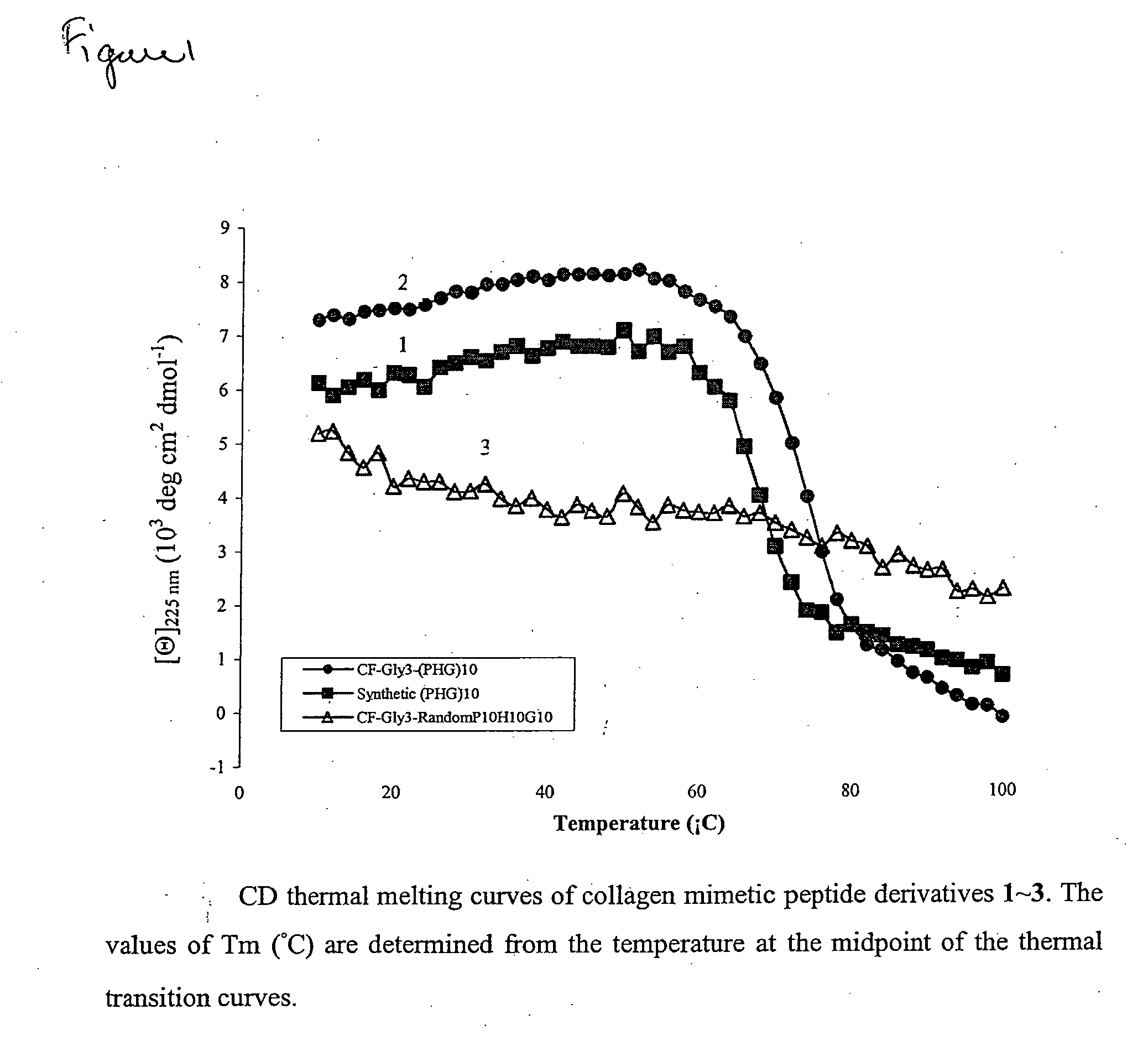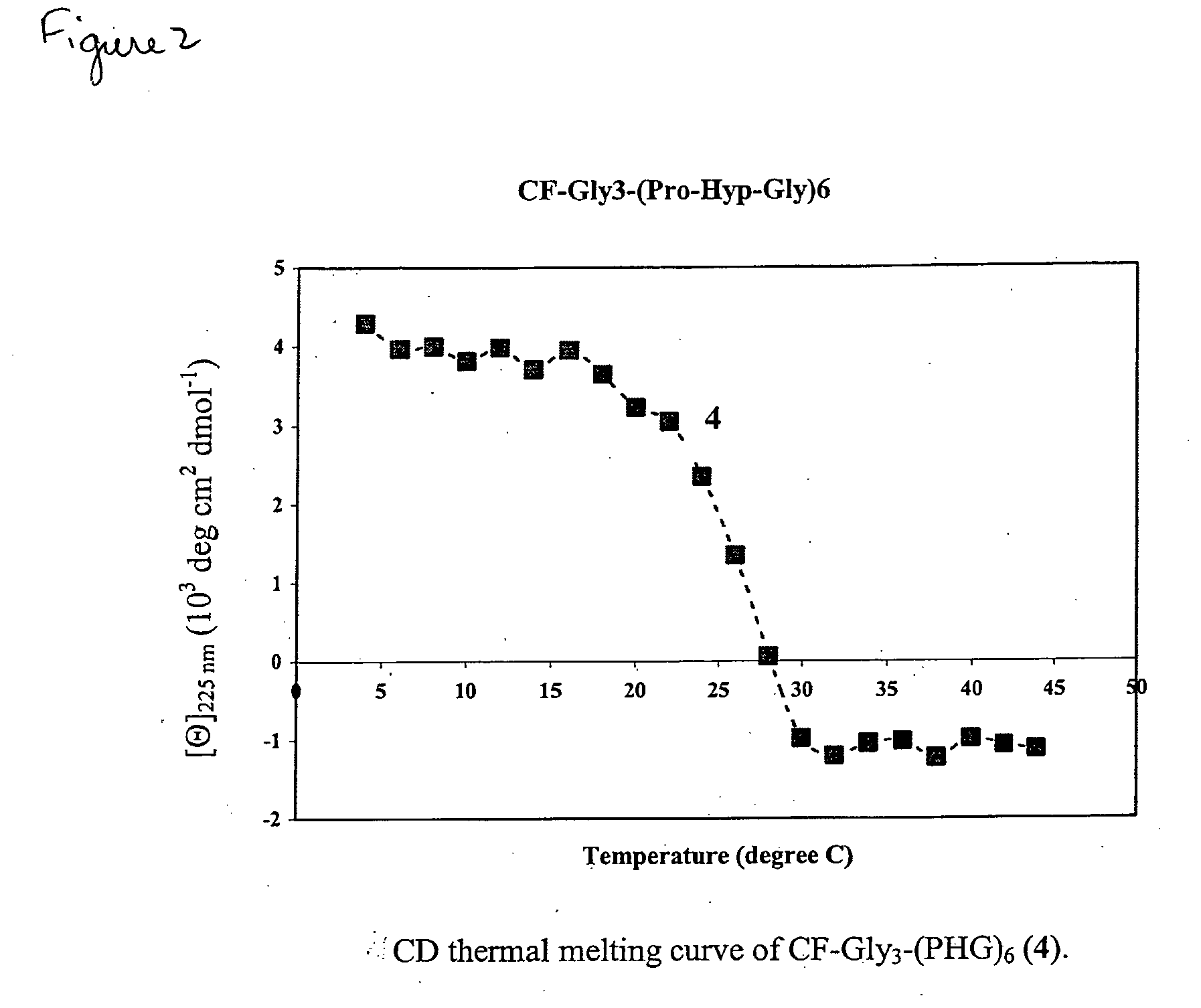Compositions Comprising Modified Collagen and Uses Therefor
- Summary
- Abstract
- Description
- Claims
- Application Information
AI Technical Summary
Benefits of technology
Problems solved by technology
Method used
Image
Examples
example 1
Methods of Characterizing a CMP or CMP Conjugate
[0209]To determine whether the propensity of CMPs to form collagen-like triple helices enables it to bind to partially denatured collagen by associating with disentangled domains of the collagen molecules, CMP and 5-carboxy fluorescein (5CF) labeled CMP derivatives were prepared as shown in Table 1 (Table 1:1 and 2, respectively), which provides the sequence and transition melting temperature (Tm) of peptides 1-5, as determined by circular dichroism spectroscopy (FIGS. 1-3).
TABLE 1Transition Temperatures of Collagen Mimetic PeptideDerivatives Determined by Circular Dichroism Spectroscopya.CompoundSequenceTm1-(ProHypGly)10-69° C.25CF-Gly3-(ProHypGly)10-75° C. 3b5CF-Gly3-randomPro10Hyp10Gly10-—45CF-Gly3-(ProHypGly)6-25° C. 5cmPEG2000-Gly3-(ProHypGly)7-29° C.ameasured in 57.5 μM acetic acid solution.b5CF-GGGGPPPHPHGPGGGPPHPPHGPHGPPHPGPHPHPGGPHPHPP, (PH:Hyp).cmPEG2000: CH3O—(CH2—CH2—O)n—OH, 2250 Da
[0210]In addition, peptide 3 was synthesiz...
example 2
Use of PEG-CMP for the Organization of Endothelial Cell Growth
[0223]Results using PEG-CMP to repel fibroblast cell growth suggest that PEG-CMP can be used to direct the growth and organization of endothelial cell growth as well, given the similarities that exist between the two cell types. Like fibroblasts, endothelial cells rely on integrin-ECM interaction for initial binding to the scaffolds. To determine the effects of PEG-CMP collagen gels on proliferation, tubulogenesis, and capillary sprouting collagen (type I) films are treated with PEG-CMP of varying concentrations. The amount and pattern of immobilized PEG-CMP present in the collagen film is determined using fluororescien labeled-PEG. Endothelial cells are then plated on PEG-CMP modified collagen and cell attachment, morphology, and cytoskeletal organization is assessed to determine the effect of CMP-PEG modified collagen on cell attachment pattern and cell proliferation. Methods of characterizing cytoskeletal organization ...
example 3
Tissue Fixation Using (CMP)n Conjugated-Homo Multifunctional PEG as a Cross-Linker
[0226]Present methods for tissue fixation use crosslinking reagents, such as formaldehyde, glutaraldehyde (GA), expoxy compounds, carbodiimide, proanthocyanidin and reactive multifunctional PEGs18,19. The use of such reagents reduces the antigenicity of many proteins and increases their resistance to enzymatic degradation when tissues treated with these reagents are implanted20,21]. Additional drawbacks to the use of such agents includes their toxicity, unmanageable crosslinking rates, and instability. The present invention provides a collagen crosslinking reagent that exhibits low cytotoxicity and can form biocompatible crosslinked products. CMPs conjugated onto multi-armed PEG compounds mediate physical binding to collagen and can serve as crosslinking reagents. CMP conjugated with homo-bifunctional or homo-tetrafunctional PEG, which are commercially available from NEKTAR (San Carlos, Calif.) (such a...
PUM
| Property | Measurement | Unit |
|---|---|---|
| Composition | aaaaa | aaaaa |
| Adhesion strength | aaaaa | aaaaa |
| Adhesivity | aaaaa | aaaaa |
Abstract
Description
Claims
Application Information
 Login to View More
Login to View More - R&D
- Intellectual Property
- Life Sciences
- Materials
- Tech Scout
- Unparalleled Data Quality
- Higher Quality Content
- 60% Fewer Hallucinations
Browse by: Latest US Patents, China's latest patents, Technical Efficacy Thesaurus, Application Domain, Technology Topic, Popular Technical Reports.
© 2025 PatSnap. All rights reserved.Legal|Privacy policy|Modern Slavery Act Transparency Statement|Sitemap|About US| Contact US: help@patsnap.com



